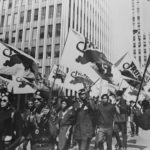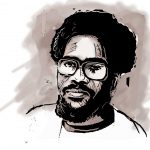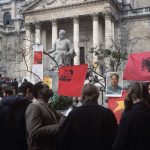Beneath the imperial paving stones of 1968
Vijay Prashad charts the colonial roots of the 1968 revolution and challenges the false narrative that democracy came to most colonised countries through liberalism and not by the gun.
Author:
30 January 2019

In December 1960, the United Nations General Assembly passed a resolution on decolonisation. “The process of liberation,” agreed the nations of the world, “is irresistible and irreversible.” This resolution was the summary of major fights from Cuba and Vietnam to Indonesia and Egypt.
Over the course of the 1960s, a broad understanding emerged in the former colonial world about the necessity of freedom from colonialism and imperialism. The temperament of the various national liberation struggles differed based on the class alignment of their leading organisations. It is this difference that fractured the new nations in the anti-colonial world.
There were rightward-leaning states and leftward-leaning states, but each of them – from Saudi Arabia to Tanzania – would remain within the non-aligned movement (NAM), created in 1961. By 1973, even the rightward states would acknowledge the radical agenda set by the NAM in its new international economic order (NIEO). Indeed, even countries like Saudi Arabia and Brazil – steeped in monarchies and military dictatorships – found merit in the argument that the global economic and political order needed to be reformed.
Related article:
The tempo of the rebellions in the 1960s outside the West was set not by student unrest nor by disenchantment with advanced capitalism, but by anti-colonial struggles and by the attempt to create this NIEO – a slate of proposals that included independence for the colonised world and full independence from the neocolonial world, which suffocated the economic independence of the new states.
New states that won their independence after the Second World War gathered at Bandung, Indonesia in 1955. There they laid out the outlines of what would be considered a “non-aligned” foreign policy. These were states led by political movements that had a range of class alignments and therefore of domestic policies. There was, however, broad agreement against the dangers of warfare (particularly nuclear warfare) and for the creation of the context for a national development agenda. It was these states – notably Egypt, India and Yugoslavia – that led the way for the creation of NAM in 1961 and that same year the committee of 24 or the decolonisation committee in the United Nations.
This inter-state movement had a cognate in the United Nations through the Group of 77 (G-77), formed in 1964 at the UN conference of trade and development. It was out of their agenda that the guts of the NIEO was crafted: subsidies and tariffs to grow national economies, cartels to protect prices of exported raw minerals, preferential financing to go around the prohibitive rates set by banks and so on.
Related article:
By the mid-1960s, the NAM was challenged on its right and left flanks. From the right came NAM states that had formed close associations with imperialism, whether by joining the Manila or Baghdad “security” pacts or by the formation in 1969 of the organisation of Islamic cooperation (led by Saudi Arabia, Morocco and Pakistan).
These formations took a position against third world-style socialism and communism. From the left came the Tricontinental, a group established by Cuba of state and national liberation movements that believed in a fuller freedom – often to be attained by armed struggle. The Tricontinental would not only gather heads of states, but leaders of national liberation movements from Cape Verde to Vietnam. At the 1966 Tricontinental conference in Havana, Cuba’s President Osvaldo Dorticós Torrado, who had been present at the NAM’s founding in Belgrade, was crisp in his denunciation of the mood and strategy of conciliation to imperialism:
“The problem of underdevelopment, even of independent nations, cannot be solved with palliatives, with institutions and technical instruments that emerge out of international conferences. The cause of underdevelopment is none other than the subsistence of imperialist domination, and thus it can be overcome only through a struggle against and by total victory against imperialism.”
These were strong words. By the 1970 NAM meeting in Zambia and the 1973 NAM meeting in Algiers, the ethos of the Tricontinental would be centre-stage.
Revolutionary wars
Cuba’s revolution of 1959 could not be contained. While Castro and Dorticós laid out their vision of armed struggle on a global scale, Che Guevara was absent from Havana. He was on a secret mission in Tanzania to assist the resistance movement in the Congo. Che was disappointed. “The human element failed”, he wrote in his Congo diary. “There is no will to fight. The leaders are corrupt. In a word, there was nothing to do.” He would draft two books on economics and philosophy before moving on to his tragic mission in Bolivia.
All this was supported by the Cuban government. The export of the revolution, the Cuban leadership felt, was the essence of their revolution. At the Tricontinental conference in 1966, Castro announced that this new body would “coordinate support for revolutionary wars of liberation throughout the colonised world.” Cuba would provide logistical support and people to all liberation movements “within her means, wherever they occur”.
The imperative of armed struggle at the Tricontinental came fully developed from Amílcar Cabral of the African Party for the Independence of Guinea and Cape Verde (PAIGC), who argued, “We are not going to eliminate imperialism by shouting insults against it. For us, the best or worst shout against imperialism, whatever its form, is to take up arms and fight.” Cabral picked up the gun not out of choice, but out of necessity. The PAIGC began its independence struggle in Guinea-Bissau and Cape Verde in 1956.
Related article:
Three years later, the Portuguese authorities massacred fifty unarmed dockworkers at Pijiguiti. It was this colonial violence that pushed the PAIGC into the armed struggle that ran from 1961 to 1974. It was imperialism’s harsh face that moved the national liberation struggles of the 1960s and the 1970s into the armed phase. It was the viciousness of imperialism that denied the national aspirations of the people, of places like Vietnam and the Congo, to move to the gun.
An inventory of colonial violence would include the Malayan Emergency (1948-1960), the Kenyan Emergency (1952-1960), the French war on Algeria (1954-1962), the French war on Vietnam (1946-1954), the United States war on Vietnam (1954-1975), the failed 1961 US invasion of Cuba at the Bay of Pigs, the 1961 assassination of the Congo’s Patrice Lumumba, the United States invasion of Guatemala (1954) and the Dominican Republic (1965), and the massacre of the communists in Indonesia (1965). In the lead-up to the Tricontinental in October 1965, French and Moroccan intelligence assassinated Mehdi Ben Barka, one of the planners of the Tricontinental.
What different kind of futures might have been available to the Congo and to Morocco had the Congolese National Movement and the National Union of Popular Forces in Morocco been able to triumph? Such different futures, buried with the corpses of those who had been assassinated. It was this colonial violence that set the tactical terms for the armies of national liberation that came to Havana in 1966.
Against imperialism
The violence of the armies of national liberation was, as Cabral put it, “to answer the criminal violence of the agents of imperialism. Nobody can doubt that, whatever its local characteristics, imperialist domination implies a state of permanent violence against the nationalist forces.” Violence is the essence of imperialism, and it is the instinct of a cornered imperialist bloc. It was this violence that was on display in the Vietnamese village of My Lai in March 1968. One soldier described his mission with brutal honesty: “Our mission was not to win terrain or seize positions, but simply to kill: to kill communists and to kill as many of them as possible. Stack ’em like cordwood.”
Four years later, in 1972, Portuguese colonial troops went into the village of Wiriyamu in Mozambique and massacred between 150 and 300 villagers. Before they killed them, the Portuguese colonial troops made the villagers clap their hands and say goodbye.
By 1975, the Vietnamese had defeated the Americans, and Portugal was defeated by its African colonies. Cuba remained afloat, despite every attempt to overthrow that government. There is no question the Carnation Revolution of Portugal would not have taken place to overthrow the Estado Novo in 1974 without the wars of national liberation in Angola, Cape Verde and Mozambique. There is also no question that two decades later the apartheid regime of South Africa would not have fallen without the victory of the Angolan liberation forces with the Cubans against the South African regime in the 1987-1988 battle of Cuito Cuanavale.
By the gun
Democracy in Portugal and in South Africa was taken by the gun. It was not given by liberalism. This narrative is now submerged. It has to be revived. Not just the sounds of the battlefield, but also the stories of the doctors and the technicians, of the revolutionary educational programmes in Mozambique and Cape Verde, the attempt to build a new society out of the detritus of the colonial order. This was the revolutionary energy that is now forgotten.
It was not forgotten due to the passage of time. A condition of amnesia was produced by the corporate media and the profession of history writing, both of which became stenographers of power. There was concerted effort by the West to undermine the entire dynamic of decolonisation, from coups against the Ghanaian people (1966) to coups against the Chilean people (1973). The violence of the coloniser was slowly justified in humanitarian terms, with the West re-establishing itself as the architect of humanity which would now need to manage the violence of the native. The great decolonisation process – whose highpoint was in the 1960s and 1970s – became the prelude to poverty and war that now wracks the former third world. Beneath the paving stones in these colonised lands there is no beach. Beneath the paving stones, there are the corpses of freedom fighters.
This is the fourth in a series of five articles that examine how protests and ideas generated in 1968 changed the political, social and educational contours of the world.
Part one:
Part two:
Part three:
Part five:
This is an edited excerpt from a longer essay that first appeared in Thread.







